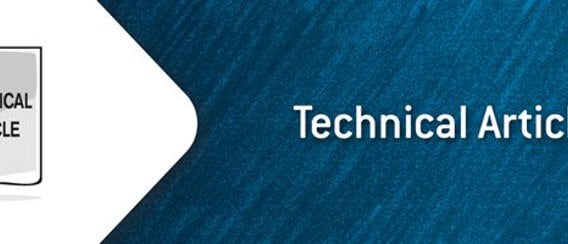Solving network operators’ pains with the novel performance endpoint device
Ethernet service deployments have dramatically increased over the last few years due to the popularity, the ease-of-use and the cost-effectiveness of Ethernet-based solutions. While Ethernet traffic, whether residential or commercial, has grown exponentially, with it comes the emergence of packet services for wireless backhaul, which has increased the strain on the network.
Loopback solutions have become mandatory devices for network testing as they typically provide address-swapping capabilities for compatibility over switched and routed networks. The emergence of Carrier Ethernet has introduced a series of nonintrusive testing protocols, such as the Ethernet OAM CFM suite (IEEE 802.1ag and ITU-T Y.1731), that now provide capabilities for continuous network monitoring and service assurance—without requiring a disruption of the customer traffic flow. These two test functions have now been combined into a single device with the introduction of the BV10 Performance Endpoint Unit.
Network Operators' Pains
As network operators shift their focus from providing Ethernet pipes for data services to becoming service enablers, they must face a number of issues when performing testing and troubleshooting. Examples of the network operators’ pains are as follows:
- As network usage increases, operators are becoming weary of sending technicians in the field or at customer premises to perform troubleshooting. For example, a typical truck roll cost is between $250 and $600 and can easily increase above these values as the complexity of troubleshooting increases. Another drawback of the truck roll is operating inefficiency as operators deploy technical and costly staff for troubleshooting, instead of using these resources for deeper issues or maintenance. Network operators need a cost-effective and permanent solution that will allow technicians and engineers to quickly troubleshoot a ticket before having to resort to truck rolls.
- Networks now carry performance-sensitive applications such as triple-play services, which are much more sensitive on certain performance parameters (like packet latency and packet jitter) than regular data services. With the increasing popularity of these services, network operators must ensure at all times that the network maintains performance within an established guideline to ensure a high quality of experience (QoE) for customers, as well as conformance to service-level agreements (SLA). Operators must find methods to always measure and assess performance without disrupting the regular traffic flow.
- Data services on telephones and portable devices created a bandwidth explosion on traditional mobile networks. Mobile network operators have turned to Ethernet to create an efficient and cost-effective packet network to handle the bandwidth constraints of mobile backhaul. As they roll out these new Ethernet services, network operators face the increasing cost of verifying and ensuring that these new roll outs perform as expected, and many operators must cut corners in order to fit within their tight budgets.
- As the number of nodes increase, especially with mobile backhaul, operators need a lucrative way to continuously monitor links. By deploying responder devices at multiple points in the network, operators increase the granularity of the monitoring system by reducing the segments legs. However, using the standard tools, the cost of deploying responders at each station is too high.
These issues are contributors to the network operators’ pains and require a cost-effective and efficient responder and loopback solution.
Responders and Test Endpoint Alternatives
Operators have always faced many challenges when testing and ensuring service integrity. As their networks grow, they are now required to test faster, while ensuring a limited impact on their customers. The typical test operation involves two key elements: the master unit (or the generator), which is primarily used to generate test traffic into the network and analyze or gather test results; and the responder, which serves as a destination for the test traffic in the network.
Network operators have turned to a number of solutions to solve these various pains. Here are some of the alternatives for test endpoints as well as their respective limitations.
Physical Loopback Devices
Physical loopback devices are the oldest form of test points, which consist of physical units that basically connect the RX and the TX interfaces. These devices are still used for telecom applications where complete circuits can be looped back without any issues. However, for data networks, physical loopback devices have extremely limited use and can only be used in layer 1 testing; while they are ideal for transparent networks, they simply cannot be used over packet-switched networks.
Truck Roll/Portable Test Set as a Responder Tool
Portable test sets have long been the solution of choice for test points. A technician with a portable device that can provide test-point capabilities is deployed at a specific site, and another technician, located at a centralized point, can execute tests to the portable test set. This solution still requires a truck roll, which should be the last-resort solution instead of the normal method of procedure. If a portable test device can offer bidirectional results (A to B and B to A), this provides powerful troubleshooting information. However, sending a technician for simple responder capabilities is often done with many portables, adding to the inefficiency of this method.
Testing with NIDs
A network interface device (NID) provides dedicated QoS implementations in small units that can be installed at the edge of the customer network. The primary function of these devices is to provide demarcation capabilities and enforce traffic-shaping and grooming capabilities without the constraints of performing extensive routing and switching functions. These devices also provide test functions, such as loopback capabilities and support for 802.1ag and Y.1731 OAM. In active test-scenarios, these devices are configured and used as loopback devices. Tests can then occur from a centralized test point to the NID loopback or from a portable device located at specific test point to the NID in loopback.
Ideally, NIDs are deployed at all handoff points and provide testing benefits such as reduced truck roll, since loopback functions can be activated remotely. And due to the fact that the device is always located at this point, there is no need to send technicians to the test site with a loopback device. Another benefit of this method is the simplification of troubleshooting; since a customer-ticket can quickly be assessed by testing to this loopback point, to verify if the issue is found from the test point to the NID location or between the NID location and the customer equipment, resulting in reduced truck rolls.
However, NIDs are an expensive solution since the test capabilities are only a fraction of the actual capabilities of the devices. This high cost for low-use impacts the ability of network supervisors to deploy a multitude of these devices at different locations, if they are only used as responder tools. Also, NIDs are in-line in the network and could potentially be an unnecessary additional failure point if used only as a responder. Finally, NIDs are more intricate devices that can add to the complexity of the test cycle.
Drivers for the BV10 Performance Endpoint Unit
Introducing the BV10, designed to interoperate and act as a companion to the entire EXFO datacom product line, from the smallest portable AXS-200/850 Ethernet Test Set to the powerful handheld/FTB-8510B/G Packet Blazer Ethernet series to the centralized RTU and monitoring Brix product lines.
The BV10 seeks to overcome the network operator’s challenges by offering an innovative device that provides the best aspect of the alternatives in a single unit, and it fulfills three key objectives.
First, the BV10 provides standards-based tools for efficient remote network maintenance and troubleshooting by providing powerful simultaneous responder capabilities in a single device. These tools include:
- Loopback capabilities which provide a wire-speed loopback solution with layer 2, 3 and 4 swap capabilities for responder capabilities over packet networks. By selecting the layer of application, network operators can run performance tests over Ethernet and IP networks without disrupting the network device’s forwarding tables. The selectable mode provides a universal application as the BV10 can interoperate with virtually all test devices in the field.
- The BV10 provides responder capabilities for Two-Way Active Measurement Protocol (or TWAMP). This protocol, defined by RFC 5357, enables two-way or round-trip measurement protocol between two host stations based on the metrics provided by the One-Way Measurement Protocol. The metrics measured include round-trip, such as packet loss, roundtrip delay, delay variation or packet jitter and out-of-sequence.
- The BV10 enables OAM capabilities via support for IEEE 802.1ag and ITU-T Y.1731 OAM CFM capabilities. Through these features, the BV10 can provide non-intrusive, in-band test capabilities for measuring performance metrics such as delay and packet jitter.
- User-datagram protocol (UDP) echo-response is a loopback application where traffic is sent to a specific UDP port (port 7 echo) and is looped back with the address swap.
- Ping request/reply: Since the BV10 is equipped with an IP address, it will respond to ping and ARP requests
Second, the BV10 is designed for unprecedented cost-efficiency and is conceived, from ground up, with the right price in mind. As it focuses on testing, the BV10 is available at a competitive price that makes it much less expensive to own and operate than either a portable test set or a NID—when considering testing functions only.
Finally, by leveraging the low cost of the BV10, service providers and network operators are able to maximize their budgets and install many BV10 units at key locations, accomplishing the ultimate objective of the BV10, which is to enable scalability for network-wide performance visibility.
With multiple BV10 units in the network, technicians responding to a trouble-ticket can quickly troubleshoot the different segments that lead to the path location issues and determine which segment is failing, therefore providing better visibility of the network. Furthermore, by combining these capabilities with a monitoring system such as the BrixNGN Next-Generation Service Assurance Software, operators can have more of a granular view of the health of the network via 24/7 monitoring based on OAM standards, consequently decreasing the response time to any arising issue.
|
|
Physical Loopback |
Portable Test Sets |
NIDs |
EXFO’s BV10 |
|
Cost |
Low |
High: Requires a truck roll |
High for simple test application |
Low |
|
Ease of use |
Yes |
No |
No |
Yes |
|
Fixed use |
Yes |
No |
Yes |
Yes |
|
Loopback |
***Layer 1 only |
Yes |
Yes |
Yes |
|
802.1ag/Y.1731 |
No |
Yes |
Yes |
Yes |
|
TWAMP |
No |
No |
No |
Yes |
|
Ping |
No |
Yes |
No |
Yes |
|
UDP echo |
No |
No |
No |
Yes |
|
Simultaneous loopback/responder capabilities |
No |
No |
Yes |
Yes |
BV10 in the Network
The BV10 can be used in a variety of test scenarios in order to better assess performance on the network.

The BV10 can be installed at a variety of key points in the network, such as in switching centers, data centers, neighborhood cabinets and at the location of key customers, to provide loopback or responder capabilities. Placing the BV10 in these major aggregation locations provides better visibility of the network by segmenting it further into smaller zones.
For mobile backhaul applications, each tower can be fitted with a BV10 to provide in-service test capabilities using such protocols as the Ethernet CFM. By deploying the BV10 over mobile backhaul, the network operator can continuously perform monitoring assessment and ensure that any degradation over the mobile network is quickly detected.
BV10 Application in the Network Lifecycle
The EXFO lifecycle proposes four distinct stages for constructing and operating a network. These stages cover the entire life of the network—from the initial construction phase to service turn-up and burn-in to the service monitoring and troubleshooting phases:
The EXFO lifecycle solution is built around key elements, providing complete coverage of the network as it evolves:
- EXFO’s Brix System is a comprehensive service-level management system that uses hardware probes to actively test in-service network at all layers of the OSI stack. IP and Ethernet testing of network services are complemented by the ability to test highly complex protocols, such as VoIP and video. What’s more, the management and presentation is centralized in the BrixWorx Correlation and Analysis Software Engine, providing executive capacity and operation reporting capabilities.
- EXFO’s RTU-310 IP Services Test Head enables carriers to ensure the reliability and performance of their Ethernet-based services. Its wide range of test functionalities provide all the necessary measurement tools for service turn-up, troubleshooting, as well as for verifying SLAs between service providers and their customers.
- EXFO’s portable test tools, such as the FTB-200 Compact Platform and the FTB-1 Platform, provide powerful Ethernet test capabilities in the field. The FTB-8510B Packet Blazer Ethernet Test Module (housed in the FTB-200) or the dedicated FTB-860 NetBlazer series (housed in the FTB-1), simplify and accelerate the deployment of Ethernet services.
The BV10 becomes a key element of the EXFO network lifecycle through its line-rate loopback functionalities with address-swap capabilities for round-trip testing. As for monitoring and nonintrusive testing, the BV10 interoperates with the Brix System by providing responder support for Ethernet OAM/CFM (802.1ag and Y.1731) as well as Two-Way Active Measurement Protocol (TWAMP).

Construction Phase
During the construction phase, the operator is building new towers, as well as deploying fiber and installing forwarding devices to link the new development to the network. During this stage, the BV10 provides a comprehensive loopback solution.
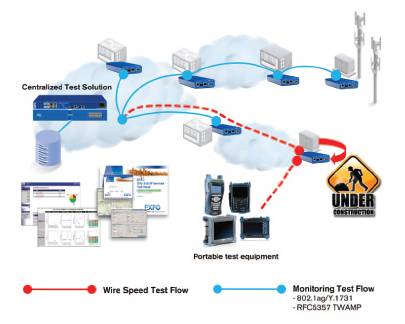
Once the fiber is extended and the network equipment is in place, the operators usually perform bit error-rate testing (BERT) to prove the stability of the network. A BV10 connected and configured in layer-2 loopback during the construction phase provides network operators with the capability to run BERT once the fiber construction is complete, ensuring error-free transmission when the service is turned up. The BERT session can be performed either from a central location or from a portable test set at an intermediate test site.
As the new construction site is being completed, network operators must ensure that the existing network services are not affected and that they provide as expected. The existing BV10 enables continuous loopback and 802.1ag and Y.1731 responder capabilities for continuous monitoring of the existing system via the EXFO Service Assurance Brix NGN system.
Service Turn-Up and Burn-In
Once the construction phase is completed, network operators must now baseline and perform service turn-up tests to ensure quality and performance before delivering the circuit. This phase is critical as it proves that the circuit can deliver the performance as specified in the SLA, which is the last phase for the customer to qualify the network before delivery to the customer.
The burn-in phase is a test phase built around long-term performance where the new circuit is kept under load for a defined soaking period, and performance is periodically measured to ensure that the minimum key performance indicators (KPIs) are met at all times.
By using the BV10, network operators can efficiently perform service turn-up and burn-in, using methodologies such as EtherSAM, RFC 2544 or the Ethernet OAM/CFM test process. The BV10 provides continuous loopback capabilities up to the wire speed, proving the maximum performance of the circuit.
Additionally, during the burn-in phase, operators can rely on the 802.1ag and Y.1731 responder capabilities of the BV10 to process requests from the central management system and to continuously monitor the network for compliancy.
A key capability of the BV10 is the simultaneous support of all responder capabilities—a key enabler for network engineers. This capability ensures that once a BV10 has been installed and configured, the network operator can perform loopback or responder-type tests without having to change the settings or to send a technician for reconfiguration. This powerful capability ensures that the device is ready for any test and provides great flexibility in the testing cycle.
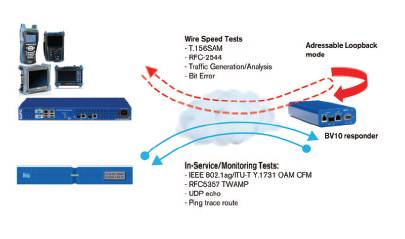
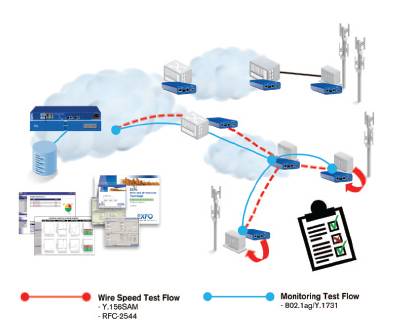
This scenario highlights a key capability of the BV10, i.e., the capability to support loopback and CFM responder simultaneously. Once the network operator installs and configures the BV10, any test can be performed to it without dispatching a technician for reconfiguration. This flexibility allows for complete test routines while leveraging the full power of the BV10.
Once the circuit complies with all specifications, a baseline report called the “birth certificate” can be completed. At this point, the circuit is now ready to be put in service or delivered to the customer.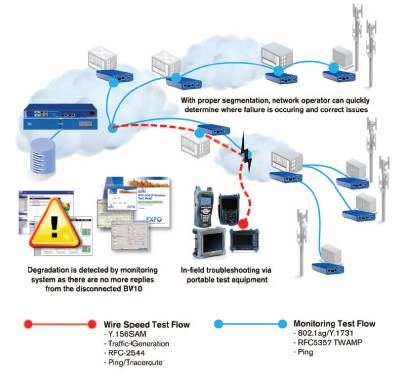
Monitoring and Troubleshooting Phases
Once the circuit is in service, the network operator must continuously monitor the service to ensure that it meets its expected KPIs at all times. A management system, such as the EXFO Service Assurance Brix System, constantly monitors links and centralizes all data, ensuring that any fault is detected and located, thus providing a quick resolution to any issue.
Furthermore, the BV10 complements the monitoring phase by providing responder capabilities to Ethernet OAM/CFM 802.1ag and Y.1731 or RFC 5357 TWAMP. For a better visibility of the network, operators can leverage the low cost of the BV10 and deploy a number of units at key junctions and locations within the network. By reducing the length of the segments, network operators can quickly determine where a fault is located and have better visibility of the network. Additionally, the BV10 complements the troubleshooting phase by providing loopback and responder capabilities to a centralized test system or to portable equipment operated by technicians in the field.
Conclusion
The BV10 is a revolutionary tool; it is an enabler for network operators and technical staff in their mission to provide comprehensive and complete responder capabilities for the entire phase of the life cycle. The BV10 is the perfect addition to any network based on three characteristics: It is the right tool, designed to fulfill the need for test responder and loopback capabilities; it is available at the right price for the right application, and it enables scalability for network-wide performance visibility.

